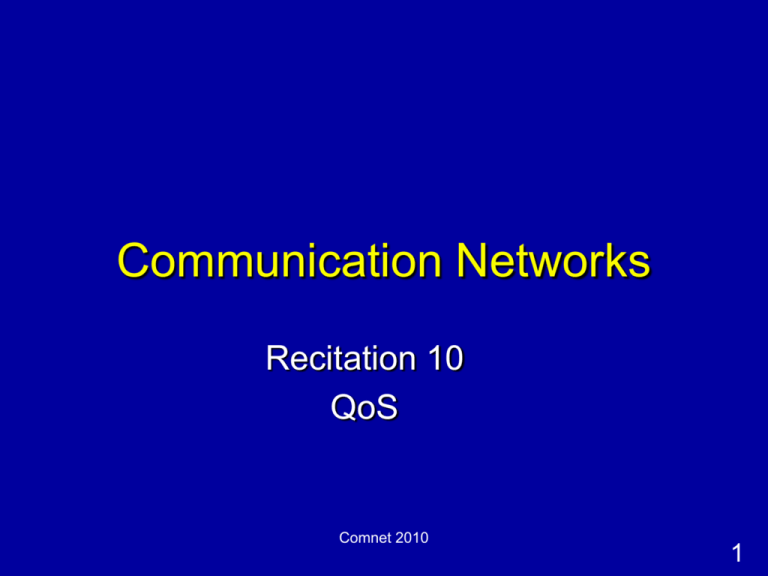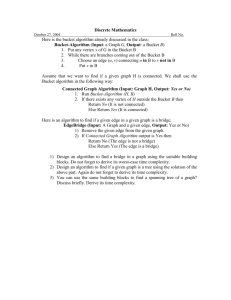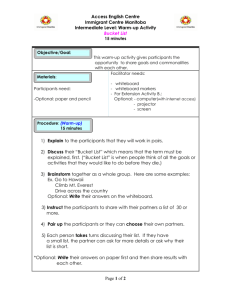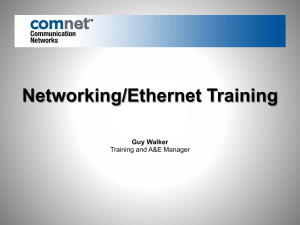CN-recitation10
advertisement

Communication Networks Recitation 10 QoS Comnet 2010 1 Quality of Service: What is it? Multimedia applications: network audio and video QoS network provides application with level of performance needed for application to function. Comnet 2010 2 Traffic Shaping The Leaky Bucket Algorithm (a) A leaky bucket with water. (b) a leaky bucket with packets. Comnet 2010 3 Leaky Bucket example • A source generates data in terms of bursts: 3 MB bursts lasting 2 msec once every 100 msec. • The network offers a bandwidth of 60 MB/sec. • The leaky bucket has a capacity of 4 MB. How does the output look like? • Input: 0-2 msec: 1500 MB/sec; 100-102 msec: 1500 MB/sec; 200-202 msec: 1500 MB/sec; … • Output: 0-50 msec: 60 MB/sec; 100-150 msec: 60 MB/sec; …. Comnet 2010 4 Leaky Bucket CNTD. • What should be the capacity of the leaky bucket to avoid loss? • During the burst, data inflow is at the rate of 1.5 MB/msec and the outflow is at the rate of 0.06 MB/msec. • So accumulation is at the rate of 1.44 MB/msec. So at the end of 2 msec, there will be an accumulation of 2.88 MB. This is the minimum leaky bucket capacity to avoid buffer overflow and hence data loss. Comnet 2010 5 The Token Bucket Algorithm 5-34 (a) Before. (b) After. Token bucket allows some burstiness (up to the number of token the bucket can hold) Comnet 2010 6 Token Bucket – simple example • 2 tokens of size 100 bytes added each second to the token bucket of capacity 500 bytes – Avg. rate = 200 bytes/sec, burst size = 500 bytes – Packets bigger than 500 bytes will never be sent – Peak rate is unbounded – i.e., 500 bytes of burst can be transmitted arbitrarily fast Comnet 2010 7 Token Bucket example • • • • Bucket capacity: 1 MB Token arrival rate: 2 MB/sec Network capacity: 10 MB/sec Application produces 0.5 MB burst every 250 msec For 3 seconds • The bucket is full of tokens Comnet 2010 8 Token Bucket example CNTD. • Initially, output can be at the rate of 10 MB/s. But how long can the bucket sustain this? – First, 1MB can be sent – From then on, for X seconds, the token input rate is 2MB/s, the traffic rate is 10MB/s – 1 + 2X = 10X 8X = 1 X = 1/8 sec =125 ms – The bucket can transmit 1.25 MB in this time > 0.5MB the application produces • Output: 0-50 ms: 10 MB/s 50-250 ms: None Comnet 2010 9 Token Bucket example CNTD. • At the end of this period, the amount of tokens in the bucket is: – 1MB+250ms*2MB/s-0.5MB=1MB • So the bucket is full again! • Repeat for 3 seconds Comnet 2010 10 Minimum Bucket size and Token Rate • Discarding Bucket (Policing) – Bucket Size ≥ 0.5MB – Token Rate ≥ 0.5MB/250ms = 2MB/s • Queueing Bucket (Shaping) – How will the traffic look with Bucket Size = 200K? • • • • • 0.2+2X=10X X=0.2/8=0.025s=25ms 0-25ms : 10 MB/s = 0.25MB. 0.25MB left 0.25MB/(2MB/s) = 125ms 25-150ms: 2MB/s 150-250ms: None – Tokens after: 100ms*2MB/s=0.2MB Comnet 2010 11 (σ,ρ) Model • Over an interval of length t the number of packets/bits that are admitted is less than or equal to (σ+ρt). • Composing flows (σ1,ρ1) & (σ2,ρ2) – Resulting flow (σ1+ σ2,ρ1+ρ2) • What does a router need to support streams: (σ1,ρ1) … (σk,ρk) – Buffer size B > Σ σi – Rate R > Σ ρi • Admission Control (at the router) – Can support (σk,ρk) if – Enough buffers and bandwidth • R > Σ ρi and B > Σ σi Comnet 2010 12 (σ,ρ) Model example • The line from the previous question has router with 4MB of buffers. How many flows of the above kind can it accept? • σ = 0.5MB, ρ = 0.5MB/250ms = 2MB/s • For n flows, we require 0.5n MB buffers, 2n MB/s rate n = 5. • Each line will be served with a 0.5MB:2MB/s token bucket Comnet 2010 13 Random Early Detection (RED) • Basic premise: – router should signal congestion when the queue first starts building up (by dropping a packet) – but router should give flows time to reduce their sending rates before dropping more packets – Note: when RED is coupled with ECN, the router can simply mark a packet instead of dropping it • Therefore, packet drops should be: – early: don’t wait for queue to overflow – random: don’t drop all packets in burst, but space them Comnet 2010 QoS 14 RED • FIFO scheduling • Buffer management: – Probabilistically discard packets – Probability is computed as a function of average queue length (why average?) Discard Probability 1 0 min_th max_th queue_len Average Queue Length Comnet 2010 15 RED (cont’d) Discard Discard Probability (P) 1 0 min_th max_th queue_len Average Queue Length Enqueue Discard/Enqueue probabilistically Comnet 2010 16 RED (cont’d) • Setting the discard probability P: avg_len - min_th P max_ P max_th - min_th Discard Probability max_P 1 P 0 min_th max_th queue_len Average Queue Length avg_len Comnet 2010 17 Average vs Instantaneous Queue Comnet 2010 18







